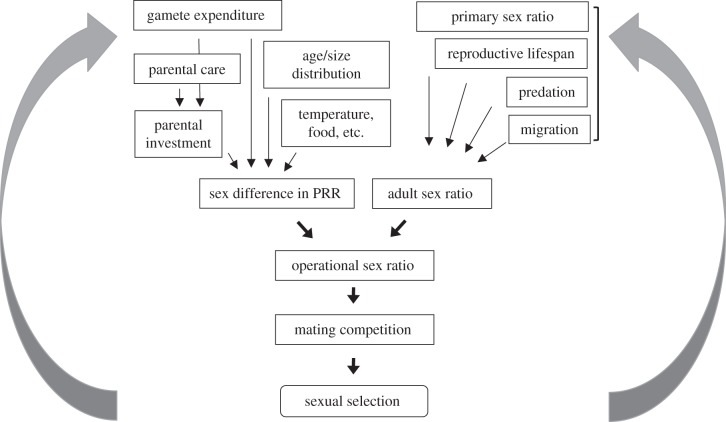Figure 1.
Operational sex ratio (OSR) is a central concept for understanding variation in mating competition and sexual selection within and between species. OSR is the ratio (m : f) or proportion (m/m + f) of males and females that are ready to mate in a population at any one time [4,9]. In many species, both sexes show some level of competition for mating opportunities. However, when the relative number of opposite sex individuals that are ready to mate becomes rare, competition intensifies, and stronger pre-copulatory sexual selection is expected among the sex in excess. The OSR in turn is influenced by the adult sex ratio (ASR) and by a sex difference in potential reproductive rates (PRRs) [5]. All else being equal, PRR is the reproductive rate individuals would achieve if they were given unlimited access to mates. If one sex has a higher PRR than the other, this difference will push the OSR towards the faster sex. A sex difference in PRR can arise due to one sex making a higher parental investment, because of higher expenditure on gametes or parental care. All else is rarely equal, however. An individual's age or size often influences its PRR, and so do ecological factors such as food availability and temperature. Especially in ectotherms such as fish, amphibians, reptiles and insects, low temperature often slows PRR. Whenever these effects on PRR differ between the sexes, they are expected to generate changes in the OSR [9,10]. While effects via PRR are typically delayed, effects via ASR are instantaneous [11]. Naturally, the primary sex ratio affects ASR fundamentally, but many other factors can also affect it, for example if the reproductive lifespan, migration pattern or predation risk differs between males and females. If acquisition of a resource, such as a nest site, is needed before an individual becomes ready (‘qualified’) to mate or breed, the qualified sex ratio should replace ASR in the flow chart [12]. Insofar as individuals benefit from multiple mates, Bateman gradients link mating competition to sexual selection. But this need not always be so, for example if individuals are monogamous, or if they compete for a territory or other resource required to mate, sexual selection can still operate without covariation between number of mates and reproductive success. As shown here, a wide range of factors can influence mating competition and sexual selection via OSR. Naturally, sexual selection can be influenced by many processes that are not included in this illustration. Our intention here is not to be exhaustive, but simply to highlight the diversity of interactions between intrinsic and extrinsic factors that underlie the form and strength of sexual selection.

